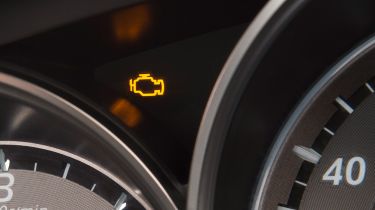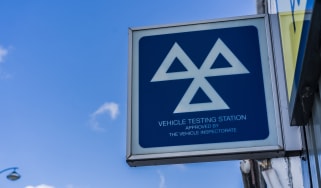Engine management light: what is it and what should you do when it comes on?
What should you do when the engine management light comes on, and how do you safely turn it off?

A car’s engine management light (EML) - also known as the check engine light - is a sight that few drivers want to see. This dashboard warning light is shaped like the outline of an engine, and it will appear when a petrol, diesel or hybrid car has detected a problem with its engine, running gear or emission-control systems.
The engine management light is a general indication of a problem, rather than a specific warning, and there are a number of issues that can cause it to make an appearance. These faults can range in severity, with anything from a faulty sensor right through to an engine misfire among the potential causes of the engine management light illuminating. Some issues can also be less obvious than others.
Here we explain what to do if your engine management light appears, and the steps you should take in order to fix the issue and avoid potentially costly damage to your car.
What is the engine management light?
The engine management light is one of a number of warning lights that's set within the instrument cluster on your car's dashboard. You're most likely to see it when you turn your ignition on, as all the dashboard lights come on and quickly go off again as your car starts up - this is to show that they are working.
The light is connected to your car's engine control unit (ECU), and is the first indicator of issues with the engine's electronic 'brain'. The ECU controls several of the car’s functions, such as the fuel and air mixture and ignition timing, to help your car's engine run smoothly.
What does the engine management light mean?
If the engine management light stays on when you start the engine, or if it comes on while you're driving, it means that the car’s ECU has detected a problem under the bonnet.
Most modern cars will show one of three variants of engine management light. This is what each one means:
Continuous amber: This indicates a fault that shouldn’t adversely impact your ability to drive the car. If the car is running normally, you should still be able to drive it to the garage. Although this may be a less-severe issue, it’s still important to get it diagnosed and fixed as soon as possible.
Flashing amber: An intermittent or continuously flashing amber light indicates a fault that is affecting the car’s ability to operate correctly. You may feel a loss of engine power, the car may start to judder or there might even be some unusual noises. You may still be able to cover a short distance but this issue must be rectified quickly.
Some cars may also flash this light in a certain sequence to highlight a specific issue that can be decoded in the owner’s manual. If you’re not entirely certain, though, it’s best to leave the diagnosis to a qualified technician.
Red: A red light indicates a severe fault. If you see this, you must stop the car as soon as it is safe to do so and then call for breakdown recovery. If you continue to drive, there is a significant risk of major damage to the engine.
What is limp mode?
In some cases, your car may go into ‘limp mode’ or ‘limp home mode’ when displaying the engine management light. This is where the ECU limits the engine’s power in order to prevent further damage to components. Limp mode is designed to get you to a safe location, so your car may still be able to get you home if you are only a short distance away. Alternatively, you might have to call your breakdown recovery provider if you need to cover a long distance.
How do I turn the engine management light off?
If your engine management light has appeared, you will need to book your car in to be inspected at a garage. If your car is still under manufacturer warranty, this will require a trip to your nearest franchised dealer.
Once at the garage, technicians will connect a computer to your car's On-Board Diagnostics (OBD) port. This will then allow them to download codes from the ECU that are created when a fault occurs. This is when you should brace yourself, because different fault codes indicate different problems, and they can range from the trivial, such as a faulty sensor, to problems with items such as the pollution control valve that manages your car's emissions.
Once any faults are diagnosed, the technician can then get to work on fixing them. The complexity of the fault and the parts involved will determine how much these repairs will cost. If your car is under warranty then this work may be covered.
Once the problem with your car has been fixed, the technician will then reset the car's ECU so that the engine management light goes off. Sometimes the system will need a second reset, while some main dealers will also take the opportunity to give your car a software update with the latest data from the manufacturer.
If the light doesn't go off, or it comes on again soon after repair, then it may mean there are still other problems lurking within your car. If the dealer is confident that there is no fault with your vehicle, get them to do another reset of the engine management light. If it keeps coming back on, put pressure on your garage to get to the bottom of what is causing it, because it shouldn't appear for no reason.
Is an engine management light an MoT failure?
The MoT regulations were revised in 2018, and the new rules included a stricter approach to cars with their engine management lights illuminated. A yellow or red warning light is now classed as a major fault, meaning the car will automatically fail its MoT. If your car’s MoT test is coming up, you will need to get the light taken care of beforehand.
Do electric cars have an engine management light?
Obviously, electric cars do not have an engine, so they technically do not need an engine management light. However, EVs are still fitted with a general fault warning light and the basic principle is the same - if the light shows, there is a problem lurking under the bonnet. This light may look the same as a traditional engine management light or be in the shape of a car with an exclamation mark, depending on the model.
What are the most common causes of an engine management light?
There are a large number of faults that can cause an engine management light to appear on your dashboard. Here are some of the most common reasons:
Emissions: Modern cars use an array of sensors to help the engine run efficiently and keep emissions under control. If an engine is burning too much or too little fuel - known as running rich or lean - this will cause an engine management light. A fault with a sensor itself could also be the cause.
Ignition: Petrol-powered cars use several components - such as spark plugs and coils - to ignite the fuel in the engine. If one of these components fails, it can cause the engine to run roughly and misfire. When the ECU detects this it will trigger the engine management light.
Diesel particulate filter (DPF): Modern diesel-powered cars are fitted with this filter to help reduce soot particles from being emitted into the atmosphere. Diesels will occasionally conduct a process known as regeneration to help burn off any excessive soot buildup. If this process fails to occur, though, and the filter becomes clogged, this will affect the engine’s ability to run smoothly. Some models have a dedicated DPF fault warning light, but others will show an engine management light instead.
Catalytic converter: A catalytic converter is fitted to exhaust systems to help prevent the most harmful gases - such as carbon monoxide - from being emitted. If this component is damaged and failing to operate correctly, it will trigger a warning. It’s vital that this issue is quickly repaired as it could prove very unsafe. Sadly, it can also prove very expensive.
Fuel cap: The engine management light isn’t always caused by a complex issue, something as simple as the fuel cap being loose could be the problem. Your fuel tank needs to remain pressurised with air as the fuel is pumped into the engine, so if sensors detect a leak in the system this will trigger a light. Whenever you fill up, check that the cap is good and tight. If it’s broken, a replacement should be cheap to buy.
Hoping to keep the engine management light at bay? These are the top 10 most reliable cars to buy...
Find a car with the experts









